The mayor says his focus on clearing unsheltered New Yorkers out of public spaces is part of a necessary strategy to connect a hard-to-reach population with city services. But housing advocates and those who’ve been subject to the sweeps say the administration is merely continuing a long-used practice that causes harm and doesn’t work.
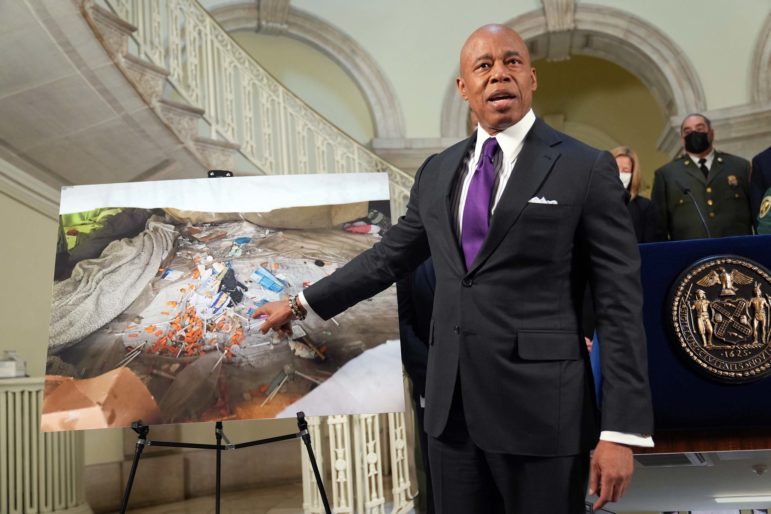
Ed Reed/Mayoral Photography Office
Mayor Adams at a press conference March 30 discussing the clean-up policy.A little less than two months after launching, Mayor Eric Adams’ campaign to clear homeless encampments from public spaces has resulted in 39 street homeless New Yorkers who accepted placement indoors—what the administration describes as steady progress, but which critics decried as a “colossal failure” that continues a controversial practice dating back to the Giuliani era.
Since March 18, the mayor’s outreach teams conducted more than 700 of these clean-ups, also known as “sweeps,” in which workers from the Sanitation Department, Department of Homeless Services (DHS) and the NYPD visit sites where unhoused people are staying and urge them to come indoors by accepting a bed in a city shelter. Often, city workers arrive alongside a garbage truck, discarding people’s tents and other possessions and at times arresting those who refuse to leave.
The Adams administration says the moves are part of a concerted effort to both clear encampments from parks and sidewalks—at times in response to complaints from local leaders and the public—and to connect street homeless residents with shelter and services. Last week, the mayor proposed allocating more than $170 million in the upcoming fiscal year budget specifically for the city’s unsheltered population, which accounts for around 2,376 people, according to the latest estimate (though experts say that is very likely a large undercount).
READ MORE: Eric Adams’ Revised Housing Budget ‘Just Not Enough,’ Despite Boost for Shelter Beds
“We’re not going to be the status quo of just walking by individuals and not addressing their mental health needs, their housing needs,” Gary Jenkins, commissioner of the city’s Department of Social Services, which runs DHS, testified at a City Council hearing Tuesday where lawmakers scrutinized the encampment sweeps policy. “That’s not good government, in any instance.”
But critics say there’s nothing novel about the Adams administration’s approach, and have called for the city to immediately cease the sweeps. Indeed, Adams’ predecessor Bill de Blasio conducted hundreds of cleanups each year, City Limits previously reported, with more than 10,000 carried out between 2016 and 2021 alone.
“If their argument is that they’ve somehow made sweeps better—our team has been on many sweeps, and this is the exact same process the last administration did,” said Craig Hughes, a social worker with the Urban Justice Center’s Safety Net Project, who also compared the policy to the “broken windows” policing style of Rudy Giuliani’s administration in the 1990s. (“You chase ’em and you chase ’em and you chase ’em and you chase ’em, and they either get the treatment that they need or you chase ’em out of the city,” Giuliani has said of his strategy during that era).
If anything, Hughes added, the Adams’ administration’s tactics are more aggressive than de Blasio’s had been. In 2020, DHS officials with the prior administration told City Limits it only conducted cleanups when encampments posed a danger to the people living there or others, acknowledging that sleeping outdoors is not technically illegal. At Tuesday’s Council hearing, by contrast, Jenkins encouraged New Yorkers to call 311 to report unhoused New Yorkers, what he described as “proactively helping” connect them to services. The next day, more than a dozen police officers arrived to clear about five tents from Tompkins Square Park, the site of multiple sweeps and protests in recent weeks, the New York Times reported.
“We did not see that level of police response in the last administration,” Hughes said.
“The sweeps don’t work,” Josh Goldfein, a staff attorney with The Legal Aid Society’s Homeless Rights Project testified to councilmembers Tuesday. “If we’ve had thousands and thousands of sweeps and we still have thousands of people on the street, it’s very clear that what we’re currently doing is not working, and it’s a huge waste of resources.”
‘A colossal failure,’ or proactive outreach?
City officials say the cleanups are part of a difficult but necessary strategy to connect a hard-to-reach population with city services and shelter. It’s not uncommon for street homeless New Yorkers to be dealing with mental health or substance abuse issues, Jenkins told lawmakers. Many have experienced trauma and are reluctant—or refuse—to stay in the city’s large congregate shelters, which can house dozens of people in the same room and which advocates say can be prone to safety issues and subpar conditions (DHS officials dispute this, saying the vast majority of city shelters, which see some 50,000 people a night, are safe).
“Outreach teams canvass the five boroughs 24 hours a day, seven days a week and 365 days a year as part of our efforts to identify and support individuals,” Jenkins testified. “It can take multiple interactions and persistent and compassionate engagement to successfully encourage someone experiencing unsheltered homelessness to accept city services.”
Between March 18 and May 1, task force teams made 733 “location visits” to encampments, city officials said, a number that includes repeat visits to the same sites, and “engaged” with 264 people during those visits. Of those, 39 people accepted placement in a shelter bed (these numbers do not include the administration’s concurrent initiative, in partnership with the state, to move homeless New Yorkers out of the subway system, which they say has resulted in another 700 people accepting city services).
“As the mayor has stated, we will not be deterred from offering the help and services to our unsheltered neighbors that they deserve and are entitled to all while ensuring that our public spaces remain clear and clean,” Jenkins said.
READ MORE: Inside NYC’s Street Homeless Sweeps, Rapid Responses and Signs of Futility
But homeless residents and their advocates say this paints a falsely rosy picture of the impact of these sweeps. City officials at Tuesday’s hearing, when questioned, said they could not immediately provide numbers on how many arrests and summonses police have made or issued in relation to the cleanups (City Hall and the NYPD did not respond to City Limits’ requests for this data), nor could they immediately provide the average cost of each street sweep, which often involves city workers from multiple agencies.
“Some of those people had been swept dozens of times,” Hughes said. “This doesn’t calculate in the vast amount of trauma that it took for whatever person to get to the point of saying, ‘Fine, after you’ve come at me so many times, thrown away my stuff, threatened to throw away my stuff, so on and so forth, I’ll finally agree to accept something.’ That’s not care and compassion, community. That is a colossal failure of human engagement.”
Hughes also took issue with several points city officials made during Tuesday’s hearing, saying it’s not reflective of what he’s seen on the ground, including their testimony that the city helps secure storage units for people coming off the street into shelter, and that they give people advanced notice of sweeps with postings in multiple languages. “I’ve never seen a single notice that’s not English,” Hughes said.
Other New Yorkers shared their own experiences with outreach teams during Tuesday’s hearing. “There have been many times where outreach or police officers, they’ve profiled me, and they’ve treated me very foul because I’m homeless,” one member of the public testified, saying they’ve dealt with housing insecurity since their teens. “They dehumanize us.”
Ashley Belcher, an outreach specialist with the advocacy group Human.nyc who was street homeless for 10 years, said past experiences with outreach teams were less than helpful.
“Anytime they would talk to me, there was no real reliable way to reach the same person who I just spoke to. No cell number, no email and no real information about permanent housing,” Belcher told councilmembers. Advocates have called for the city to stop sending police officers to respond to 311 complaints about encampments, and instead assign trained DHS workers only.
“I feel no homeless person should have to be woken up outside by police, even if outreach is beside them. It’s uncomfortable and it makes the situation worse,” Belcher said.
Councilmembers and advocates also pushed administration officials to share data on how long those 39 street homeless residents who accepted shelter placement from outreach teams actually stayed in shelter after these interactions.
“If I am moving those people and and they’re telling me, ‘Councilmember I will not go into a congregate setting,’ and I am still moving them and putting them in a congregate setting, then I know that the likelihood that they’re going to leave through the backdoor and are going to end up sleeping on another street is very high,” said Councilmember Diana Ayala, who chairs the Council’s general welfare committee.
“It does not benefit anyone. We’re moving them from one place to another,” she said.
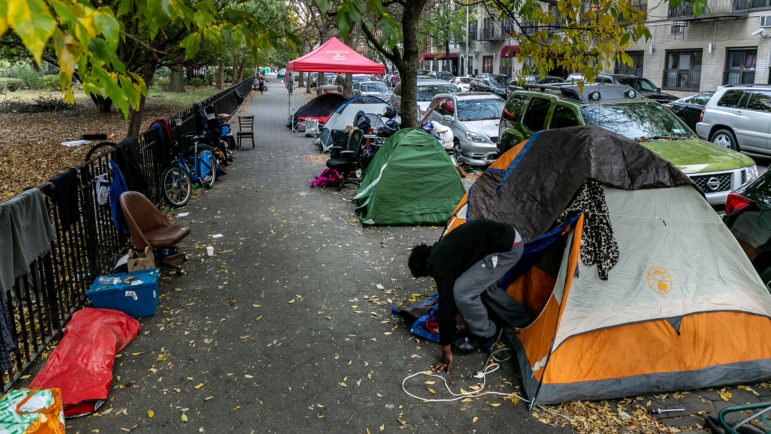
Adi Talwar
An encampment near Tompkins Square Park, pictured here in November 2021, has been the site of repeated city sweeps.The need for single-room shelters, permanent housing
The administration is focused on allocating resources to creating the types of shelter spaces that street homeless New Yorkers are more likely to use, officials say. Mayor Adams’ executive budget proposes $171 million a year for increased services specifically for the unsheltered population, which will go to expanding outreach teams, opening new drop-in centers as well as 1,400 new Safe Haven or stabilization beds, which are usually smaller and have less restrictions than traditional congregate shelters, as well as on-site services in the case of Safe Haven facilities.
DHS officials said 900 of those new beds will be in the pipeline this year. The city currently has around 2,700 of these Safe Haven or stabilization beds, and just 31 of them were vacant Tuesday, officials testified.
Advocates have stressed the need to create these new beds in single rooms, since the crowded nature of congregate shelters, and the privacy and safety issues that often come with it, are one of the main reasons people who avoid the shelter system do so.
“People will be more likely to go into a Safe Haven if they feel like they know there’s going to be at most one or two people per room instead of two dozen people,” said Karim Walker, an outreach specialist at Human.nyc. He suggested the city require that of any future contracts with shelter providers to ensure the new beds will be designed effectively.
Meanwhile, the administration’s recent efforts to open new Safe Haven sites have been stymied by community backlash. This week, the city dropped plans to open two such facilities in Chinatown after residents protested, saying the neighborhood is already overburdened with social service facilities—a decision housing advocates criticized as the city caving to public pressure.
They’ve also blasted the city’s recent decision to close other single-bed shelter spaces, including a former hotel in the financial district that’s been used to house homeless residents. “The more single rooms they close, the less and less it matters if they’re going to open stabilization and Safe Haven beds, because they will have just closed all these other rooms,” Hughes said.
Both housing advocates and city officials say that the larger solution to the homelessness crisis is permanent housing. Mayor Adams has yet to release a detailed housing plan, and his executive budget proposed allocating less funding for affordable housing construction than what advocates say is needed—and less than what he pledged he’d commit while campaigning for office last year.
“New York City has seen significant decreases in affordable housing in the decade between 2005 and 2015,” Jenkins told lawmakers at Tuesday’s hearing, adding that household rents in the city increased by 18.4 percent at the same time.
He said his agency is “laser-focused” on filling vacancies in the city’s existing network of supportive housing units—affordable apartments where residents also have access to social services, and which many tout as a key tool for combating homelessness. At the start of the year, some 2,500 of these units were empty, what experts blamed on the city’s slow-moving housing placement process and other administrative hurdles.
“We are working across our agencies again to look at the streamlining processes we have,” for filling those units, Jenkins said, saying that the number of vacant supportive units has decreased in recent months to around 1,800.
But some advocates say this won’t do much to specifically aid street homeless New Yorkers without additional reforms, since the competitive process for securing a supportive housing unit often excludes applicants with the greatest needs, including people dealing with mental illness or substance use disorders. Just about 1-in-5 supportive housing applicants actually land an apartment, which critics say allows providers to “cherry-pick” those who require the fewest services, a process known as creaming or screening.
READ MORE: NYC Council Considers Bill to Probe Why Homeless Are Denied Supportive Housing
“People in encampments are the people who will almost never get actually into supportive housing. And the people on the subways that are getting targeted by cops, they’re almost never going to get into supportive housing,” Hughes said.
“There are thousands of empty spaces, empty housing spaces right now available at the mayor’s fingertips. He could simply decide that he wants to give the city, DHS and DSS, those resources to place people in those apartments,” he added. “Instead what he’s decided to do is just chase people around and come up with any manner of excuses for why he needs 700-plus sweeps in order to get a few dozen people to accept some sort of placement.”


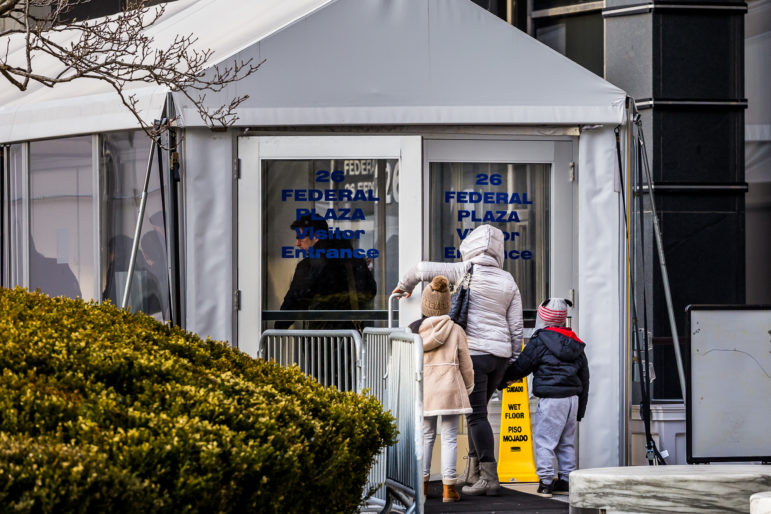
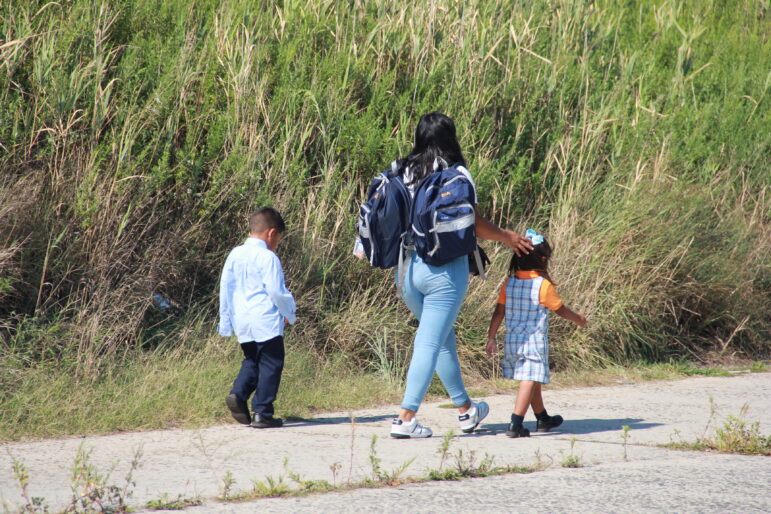
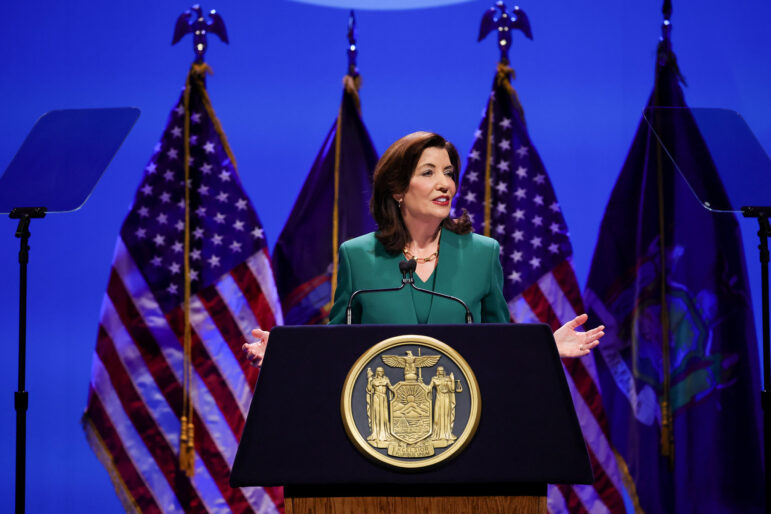
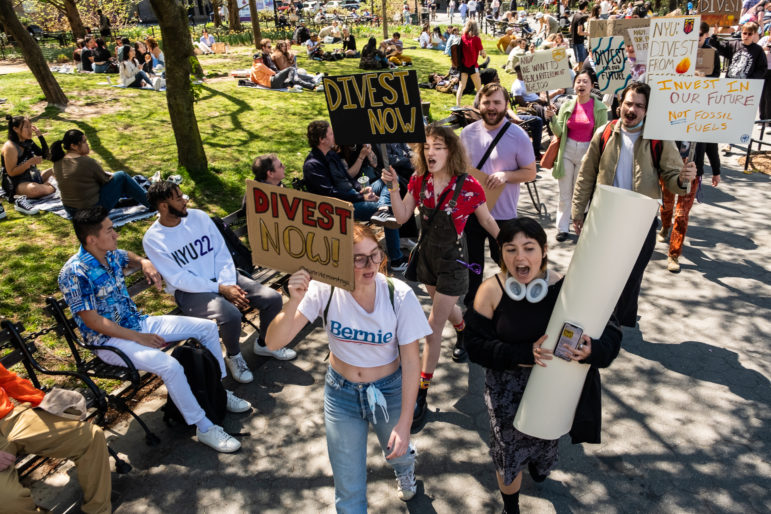
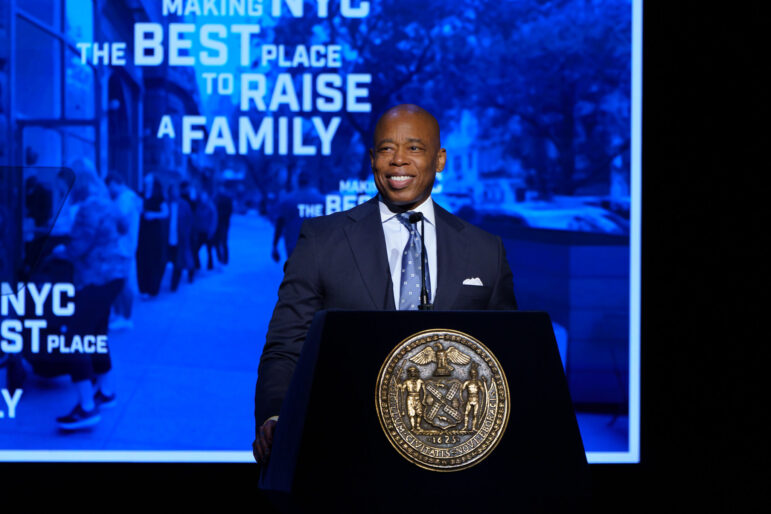


3 thoughts on “The City Touts Progress on Street Homeless Outreach. Critics Say It’s More of the Same”
Ceo Renee Mitchell of Breaking The Cycle Drop Corp. Said none of this tsunami of homeless and public safety will work in less you get rid of these large facilities of warehousing and start addressing the root cause. With wrap around service all on site . Meet them where there at . Push toward self sufficient. No wrong door approach.
Current sweeps are much more aggressive than those of previous administration–at least in my District. I think last administration didn’t really care so much. I never saw strategic response police–it was generally NCOs who knew the people. Certainly didn’t arrest people for not moving–cannot believe we even talking about that!
sense of community